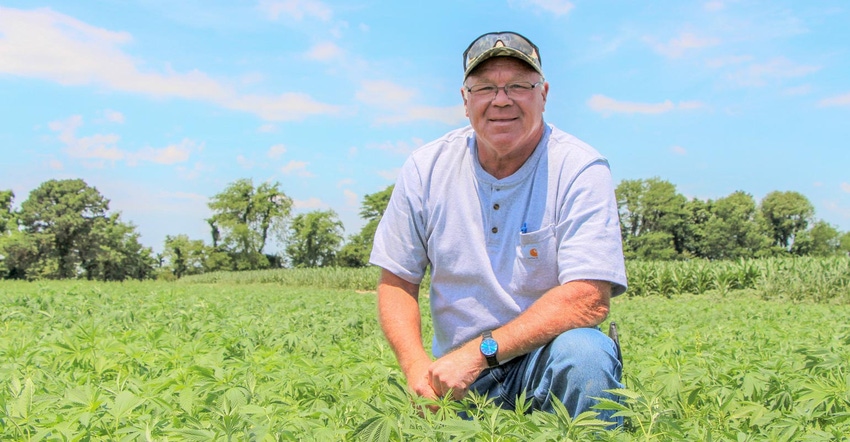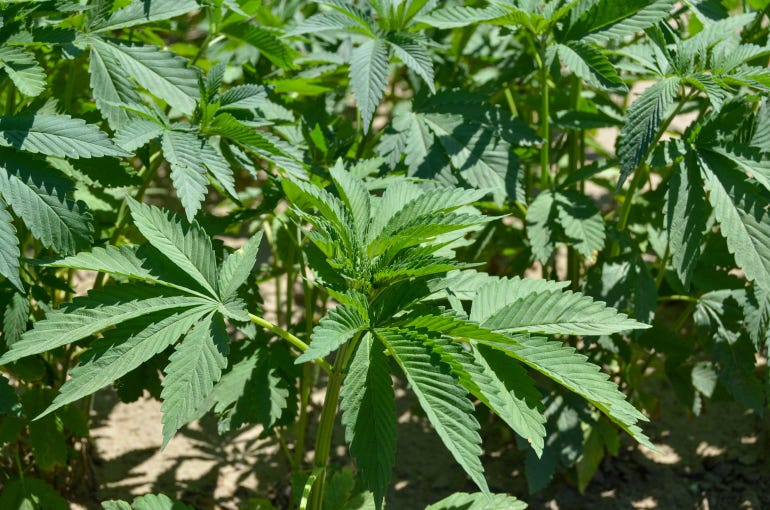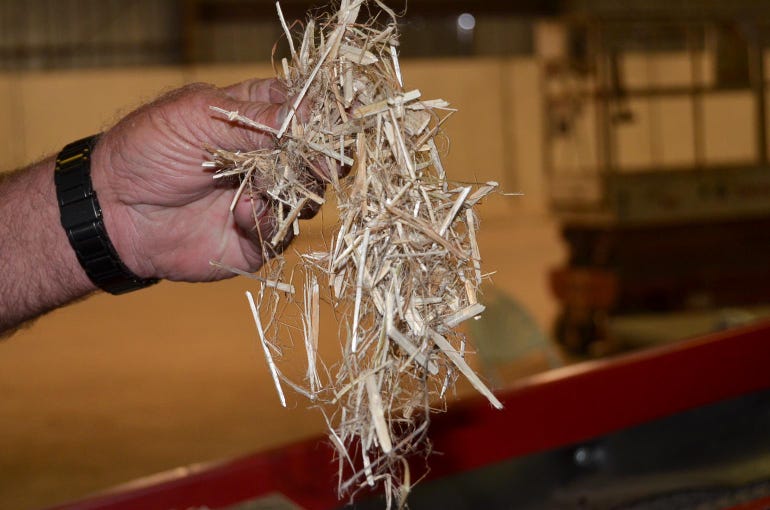
When Jeff Limbaugh looks across his hemp fields in southeast Missouri, he sees the future of sustainability — not just for farming, but also for the next generation.
Walking among the rows of hemp plants, he explains how each one plays a role in what he aptly calls the “sustainability circle.” This year, he planted 178 acres of industrial hemp in Scott County. He was one of only 191 hemp producers approved by the Missouri Department of Agriculture for the inaugural growing season.
This year’s crop is just the start of a much larger vision for Limbaugh.
“Hemp has some characteristics like the fiber in the hurd that could potentially go into the paper industry,” Limbaugh explains. So, he sees the possibility of working with companies such as Procter & Gamble as a way to create that full-circle benefit for the farmer, company and environment. Here’s how the process would work.
Limbaugh is a row crop farmer who raises corn, soybeans and cotton near Missouri’s Bootheel. But he also has side businesses. For the past 25 years, Limbaugh operated Heartland Application, which already works with companies such as Tyson and Unilever to take their industrial waste and use it to create compost through his other company, Midwest Organics. He sees paper companies such as Procter & Gamble joining the movement.
“We take their waste stream, and we turn it into a beneficial reuse as fertilizer; that fertilizer would then be used by farmers to grow the hemp," Limbaugh explains. "The hemp product would run through a hemp fiber processing facility, and that product would be sold right back to Procter & Gamble. Now you’re looking at the full circle of sustainability. Now you have a 50-mile footprint. A company’s waste product doesn’t go into a landfill. It’s a win-win-win.”
Limbaugh believes in the concept so much that this year he planted acres not only to commercial hemp fiber, but also 30 acres for university research.
Planting hemp seed
Limbaugh called companies domestically and internationally to find viable hemp seed for growing hemp fiber. He secured seed from Pennsylvania and the Ukraine. However, he expects more domestic sources as hemp production continues to expand in the U.S., as well as Missouri.
He looks for high fiber-producing hemp varieties. He found Hlukhivs’ki 51 or H-51 from a Pennsylvania supplier.
Planting began for Limbaugh in mid-April. He started with 50 pounds per acre with about 22,000 seeds per pound. In all, that is 1 million seeds per acre planted. However, he admits the first batch did not get off to the best start.
Limbaugh wanted the plants in early and to emerge quickly, out ahead of the weeds, since there are not legal herbicides for use with hemp production.
“That got derailed a little bit because the hemp seeds just didn't have the vigor and cold tolerance,” he says. “The plant doesn’t come out of the ground real aggressive. The weeds were more of a problem, so preplant herbicides in the future will be very important.”

UP CLOSE: This field is tucked away from the main highways in rural Scott County. This industrial hemp plant comes from the same plant as marijuana and is similar in looks. However, it differs in the amount of THC levels. This hemp plant is grown for its fiber.

Still he persevered. “It is a learning year,” he says. “We are going to get some things right and some things not quite as right.”
He tried a variety of planting methods such as no-till after a rain and minimum till, simply fluffing the ground. Limbaugh found that no matter the tillage method, hemp does not like "wet feet."
“So, what we found best was to work the ground. Either run a center pivot or wait for rain,” he explains. “We had a moderate rain on our fields, and then we were able to go in and set our drill at a very shallow half-inch depth.”
Like any farmer, Limbaugh laughs as he found the right planting model came with the last attempt. “We had a real good stand out of it,” he quips. “Unfortunately, that was one of the last things we tried.”
He says another hemp seed planting scenario that didn’t work well was opening the ground and placing the seed down to the moisture. Then the rain came and crusted the soil over it. “Hemp just doesn’t have the vigor to push through the layers,” Limbaugh says. “So, like any other crop, we had to replant.”
It’s a learning curve this year, but he is narrowing down the planting models. “We're working very, very hard at trying to figure out the best method, the best practice of, to be able to share with everybody in the state of Missouri," Limbaugh says.
Hemp plant calls for fertilizer
With hemp plants grown for fiber reaching heights of 10 feet, it requires ample nutrients. “They get as big around as a pencil all the way up, with a number of leaves,” Limbaugh notes, “so we need a solid NPK program.”
Across the state, he notes, the University of Missouri also has hemp research trials focusing on nitrogen inputs. Limbaugh is trying out a few application rates on his own farm.
Some of the university's test plots are shooting for 100 units of nitrogen total. Limbaugh has small plots putting 125 units and 150 units, and one with 150 units of nitrogen spread across the entire field. He says at the end of harvest, there should be a better idea of what type of NPK program will work for hemp production in Missouri.
Plant growth through the months
Limbaugh figures hemp to be a 100-day growing crop, and while it got off to a slow start in May, it gained height over the months that followed.
By the end of June, the hemp plants were a little more than 3½ feet tall. Two weeks later, it quickly jumped to 5 feet. In mid-July, the hemp plants measured above 7 feet, and two weeks later, some fields had plants reaching 9 feet.
“They grow extremely fast after they reach about 12 feet tall,” Limbaugh says. The area, with its sandy soil and adequate moisture, is on track for a robust hemp fiber crop. At this pace, he expects to start harvest around the middle of September.
Harvest-ready fields
It takes basic hay equipment to harvest a fiber hemp crop. Fortunately, Limbaugh also is a cattle producer who owns a mower, rake and baler. But farmers cannot rush the harvest season. There is a process for gathering hemp.
“It may take two or maybe three weeks, depending on when you mow it down,” Limbaugh explains. “You have to rake it into swaths and allow time for the retting process.”
Retting is a natural decomposition of the hemp fiber plant where it breaks down the fiber, which accounts for about 30% of the outside of the plant. And here is where Limbaugh says it will be another learning curve in industrial hemp production.
“We have to find just how long that time is,” he explains. “I know that if retted correctly, it goes through the equipment better.”
After the retting process is complete, farmers can bale it up. However, Limbaugh says they should talk with their buyer to see if they prefer it in large round or square bales for processing. For Limbaugh, that is 4-by-5 big round bales he delivers to Tiger Fiber, a hemp fiber company located in nearby Sikeston, Mo.
Hemp product delivery
Tiger Fiber is a new company in Missouri that is setting up a processing plant for hemp in southeastern Missouri. “It is going to be a must to have somebody like Tiger Fiber buy the product,” Limbaugh says.
The company was formed in August 2018, but according to its co-founder and CEO Patrick Van Meter, it has been working on the advocacy of hemp for the past three years. “We were just trying to understand why hemp wasn’t legal here and what we could possibly do to help support bringing it online in Missouri,” he says.
What Van Meter found was a lack of infrastructure. So his company rented out an old Cargill facility in Sikeston, Mo. This facility already holds a decorticator, which separates the fiber off the hurd. It continues to add equipment, ramping up operations before receiving hemp bales in October.
“You can make concrete or mix it with lime for small animal bedding,” Van Meter says. “It looks and feels and performs a lot like wood, except for half the weight and high absorption quality.”

MARKET PRODUCT: Hemp grown for fiber has many uses in the construction industry in terms of making it into concrete or wood. It also is used in the textile industry for clothing. It takes companies such as Tiger Fiber to start the refining process.

Tiger Fiber is involved in the initial steps of the cleaning process. Van Meter says after hemp goes through the decorticator, it is further cleaned, sized and separated again. But it takes a Tiger Fiber along with farmers to get the process started.
Limbaugh likens the fiber processing company to a cotton gin. “I can raise cotton, but I can’t do anything with it without a cotton gin,” he explains. “They have to make it into something to pass up the line, allowing companies to turn it into clothing. You have to have each other to make the commodity into something usable.”
And that makes Limbaugh excited. He sees it as another step closer to closing his circle of sustainability. “For the most part, every acre of beans, every acre of corn, every acre of cotton, every acre of wheat grown in the state of Missouri has almost little to no repurposing in the state,” he says. “Hemp has the possibility of the farmer growing it, increasing his bottom line, then a company like Tiger Fiber being able to process it, which means jobs not only for this community, but many potential jobs within the state by keeping Missouri-grown products in Missouri. It is such a positive for the state.”
About the Author(s)
You May Also Like






